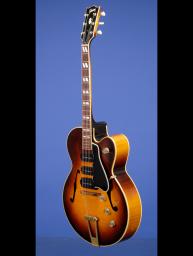The Birth of Gibson's ES-5 Guitar…
1949 Gibson ES-350 Special.
The birth of the Gibson ES-5… The very first electric guitar with three pickups… This is the exceptionally rare prototype version of the ES-5 masquerading as a three-pickup ES-350. One of only twelve of an experimental batch of ES-350 Specials made by Gibson during June and July of 1949. This 17-inch-wide single soft (Venetian) cutaway guitar weighs just 6.70 lbs. and has a nice, fat nut width of 1 11/16 inches and a scale length of 25 1/2 inches. A wonderfully flamed one-piece solid carved maple top, one-piece highly-flamed maple back and sides with triple binding on the top and bottom edges. Two-piece maple neck with a center mahogany strip and a wonderful thick profile. Bound Brazilian rosewood fretboard with 20 original thin frets and inlaid pearl split-parallelogram position markers. Single-bound headstock with inlaid pearl "Gibson" logo and pearl crown inlay. Single-layer black plastic bell-shaped truss rod cover with two screws. Individual gold-plated 'single-line' Kluson deluxe tuners with "PAT./APPLD." stamped on the bottom edge of the cover and "2356766 / PAT APPLD." stamped on the underside (earliest style with no outside hole for the tuner worm shaft). Single ring tulip shaped keystone buttons. Three original P-90 single-coil pickups with outputs of 7.45k, 7.19k and 7.05k. Original beveled five-layer (black / white / black / white / black) plastic pickguard. Four controls (three volume on lower treble bout, plus one master tone on upper treble bout). Original clear plastic barrel-shaped 1/2 inch tall "Speed" knobs with no numbers. Inside the bass 'f' hole is the white oval Gibson label with "E-S-350" and the "A" of the serial number written in black ink. The "3372" of the serial number is stamped in black. Inside the treble 'f' hole are the FON (factory order number) letters "1000 27" (corresponding with May/June 1949) stamped in black. Rosewood bridge with pre-set compensating saddle on rosewood base. Original trapeze tailpiece with pointed ends and three small raised parallelograms on cross-bar. All hardware gold-plated. This near mint (9.25) condition sixty year old masterpiece has the bare minimum of finish checking and a few miniscule surface marks which are all that prevent us from actually calling it MINT. The original small frets show very little signs of wear and the guitar is an absolute delight to see, play and listen to… Housed in it's original Gibson four-latch "Lifton" brown hardshell case with pink plush lining (8.50)
This amazing piece of musical history (from the world renowned Chinery collection) is featured on pp. 74/75 of Tony Bacon's book The History of The American Guitar from 1833 to the Present Day.
"Gibson's archtop f-hole electric guitar had come on in leaps and bounds since the company's earliest experiments in the 1930's with models such as the ground breaking ES-150. Soon the budget ES-100 and high-end ES-300 were added., before America's entry into World War ll in 1942 when Gibson effectively put a halt to its guitar production. As instrument manufacturing recommenced after the war, Gibson rightly believed that the electric guitar was set to become an important part of its reactivated business. The significant new archtop electrics that debuted during this period - the ES-350 of 1947, and the ES-175 and ES-5 of 1949 - were aimed at players who were prepared to commit themselves to fully electric instruments that were designed and built as such by Gibson. It was also at this time that Gibson began to pioneer electric guitars with cutaways. This made a good deal of sense. In some musical settings there was little point in playing high up the neck of acoustic guitars as the results might not be audible. But on an instrument equipped with a pickup and suitably amplified, a cutaway offered easier access to the now audible and musically useful area of the upper fingerboard. Talented and imaginative players openly welcomed the artistic potential of the cutaway and began to investigate the dusty end of the fingerboard. The ES-350 of 1947 was the first of the new style cutaway Gibson electrics (and indeed at first it bore the "Premier" tag of the pre-war cutaway acoustics). The ES-350 was followed in 1949 by the new ES-175, Gibson's first electric guitar with a "pointed" cutaway style and a presses, laminated top. The ES-5 appeared in the same year as the 175, and was among the earliest (and indeed probably the very first) electric guitars to be offered with a compliment of three pickups. A 1950 catalog described the new ES-5 in glowing terms: "The supreme electronic version of the famed Gibson L-5, the ES-5 Electric Spanish Guitar combines the acclaimed features of the L-5 with the finest method of electronic guitar amplification. Three separately controlled, adjustable, magnetic pickups reproduce the full, rich tones and harmonics to make the ES-5 truly 'the instrument of a thousand voices.'"
Interestingly if one looks at A.R. Duchossoir's Gibson Electrics The Classic Years (p. 166), of the ES-5, he states "The first variant is primarily characterized by its 4-control circuitry, without any switch for pickup selection. Consequently, pickup combinations are achieved via the settings of each of the three volume controls. According to factory records, the first ES-5 was made by converting an L-5C (#A3198 registered on 26th May 1949) into a three pickup electric. The earliest production model (#A3227) was registered shortly thereafter on 9th June 1949."
Our guitar (#A-3372) is one of the batch of twelve that appear in the Gibson shipping records as having being made during June and July of 1949 and marked in the ledger as "ES-350 Sp." (for "Special") over which has been stamped in ink "ES-5." Clearly what we have here is the birth of Gibson's ES-5 guitar, in its earliest form.
From the above we can safely deduce that in fact #A-3227 was in fact the first of the batch of 12 (June 9th, 1949) and that our guitar followed shortly thereafter.










